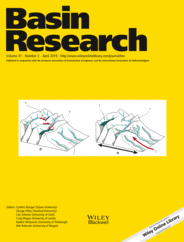
Full text loading...
 , Guillaume Duclaux3, Hao Wu1, Chonglong Gao1, Longdi Li1, Liang Chang4
, Guillaume Duclaux3, Hao Wu1, Chonglong Gao1, Longdi Li1, Liang Chang4
The role of spatiotemporally varying tectonic forcing in the development of stratigraphic patterns along passive margins and continental rift basins has been recognized for decades, but the exact nature of the stratigraphic response is still debated. This study develops a coupled tectonic‐stratigraphic numerical model with a fixed absolute lake level and constant climate conditions to quantify the signatures of spatiotemporally varying tectonic forcing on the stratigraphic record. This model consists of a three‐dimensional rift basin with a range of geomorphic features and produces a number of well‐recognized stratigraphic patterns, which are commonly interpreted to be caused by lake‐/sea‐level or climate fluctuations. This study demonstrates that the shoreline and grain‐size front are decoupled through the adjustment of the depositional slope and sediment dispersal under spatiotemporally varying tectonic forcing, especially in underfilled basins. Under such a decoupled situation, the pathway of the migrating subsidence centre correlates with the pathway of the grain‐size front, a result of competition between spatiotemporally varying tectonic forcing and autogenic sediment transport. The model results also highlight the significance of three‐dimensional variability in the stratigraphic response to tectonic forcing, which may be overlooked or misinterpreted and suggests a high degree of uncertainty in re‐establishing the base‐level cycles from the stratigraphic record alone. Moreover, spectral analysis of the modelled stratigraphy and tectonic forcing suggests that low‐frequency tectonic signals are more likely to be recorded in the stratigraphy with a lag time, whereas high‐frequency tectonic signals are likely to be shredded, mixed with autogenic signals, or buffered through sediment‐routing systems. Finally, quantitative measurements of the stratigraphic architecture of the Nanpu sag in the Bohai Bay Basin, China are used to tune the numerical model of this study to illustrate how to evaluate the role of tectonic forcing on the development of characteristic stratigraphic sequences.

Article metrics loading...

Full text loading...
References


Data & Media loading...
Supplements

